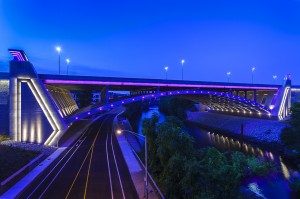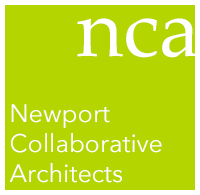
Photo Credit: Carl Vernlund
AIA Rhode Island, a chapter of the American Institute of Architects honored Northeast Collaborative Architects with a design award for the Pawtucket River Bridge, Pawtucket, R.I. The annual competition celebrates outstanding works of architecture from Rhode Island architects and honors the project teams and clients who work with them.
The Pawtucket River Bridge earned the highest honor, the 2013 Honor Award for Urban Design. Native Americans call the place where trails meet to cross a riverPawtucket. During the 18th Century settlers crossed the Pawtucket River seeking religious freedom in Rhode Island Colony. During the 19th century, Pawtucket’s Slater’s Mill marked the birthplace of the Industrial Revolution and the bridge spanning the river became a commercial thoroughfare. By the mid-20th century, Interstate 95 was the most traveled highway in the nation. In 1958 a new Pawtucket River Bridge was built to carry I-95 traffic over the Pawtucket River.
According to the Rhode Island Department of Transportation, 162,000 vehicles travel across the Pawtucket River Bridge every day. The defective Route 95 overpass created an opportunity to demonstrate that State and Federal governments could collaborate with the design team to replace the aging Pawtucket River Bridge and revitalize the historic city’s gateway.
NCA’s design challenge was not to create a linkage over a relatively narrow New England waterway but to convey the series of extraordinary events that for centuries converged at this very spot. From hand-hewn covered bridges to steel and concrete marvels, Rhode Islanders have long expressed pride in bridges and regard them as iconic structures.
The project entailed replacing three separate structures with a bridge to carry I-95 Northbound; a bridge to carry I-95 Southbound; and a bridge for the on and off ramps to George and School Streets. Inspiration for the bridge’s Art Deco design came from other structures in Pawtucket built during the Great Depression, such as City Hall, McCoy Stadium and Shea High School. The new bridge’s four pillars feature representations of Art Deco wings on the eagles chiseled atop the tower at City Hall. Seen from the river, the bridge, made of metalized steel and illuminated at night with colored LED (light-emitting diode) lighting, displays a graceful silvery arch over the Pawtucket River. The project cost $80 million and was completed in 2013.
The Jury’s official comment about the Pawtucket River Bridge was, “The world seems to have forgotten Architecture’s ability to infuse spirit into infrastructure in the public realm. The Pawtucket River Bridge is a powerful reminder of that potential. The jury recognized two major successes here: The design achievement itself, with kudos to the architects; and the wisdom of the public client in the act of commissioning an architect. We therefore gave it the highest award as an Urban Design achievement. The bridge exhibits a strong iconography, unique to this particular crossing, with its particular way of engaging the span with its abutments, and harkening back to the original bridge’s eagle-motif. The referential nature of these design moves are made contemporary and purposeful through the honest expression of structural form. Acting as an extension of the city in the landscape, it is both connector and gateway and will undoubtedly be memorable to Pawtucket’s innumerable visitors and residents. The jury was impressed with the weave of transportation modes that this structure creates. Walkers, bikers, boaters, and automobile passengers share the experience of this structure in distinct yet integrated ways.”
